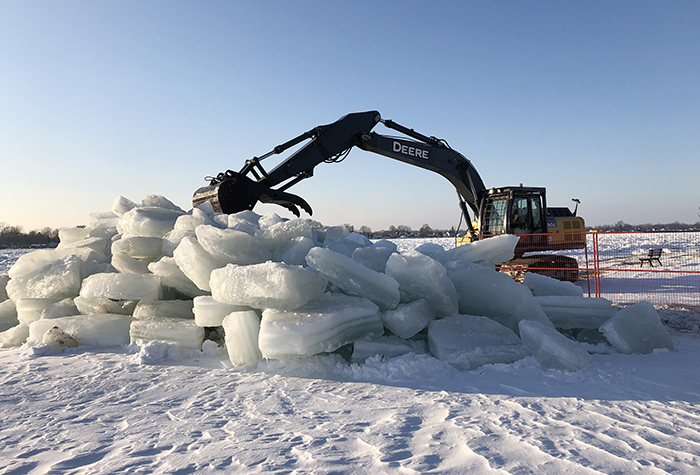
By Pam Wright
Local Journalism Initiative Reporter
For the first time ever, the effect of ice cover on the Great Lakes is being studied in depth.
It’s all part of the Winter Grab – a co-ordinated effort between universities and environmental agencies to plumb the mysteries of what’s really going under the surface.
During the week of Feb. 14-18, dozens of scientists from the western tip of Lake Superior to the eastern edge of Lake Ontario took samples of water and plant life to create a snapshot in time.
According to Dr. Mike McKay, executive director of the Great Lakes Institute of Environmental Research at the University of Windsor, it’s a subject that hasn’t undergone much study.
“We recognize we know very little about what goes on under the ice,” McKay said in a recent interview.
Traditionally, he explained, there’s been a view that waterways are dormant in winter with not much going on under the surface.
But Winter Grab, founded by a University of Minnesota scientist, is looking to change that.
As global temperatures rise and climate change escalates, bringing wilder weather with it, Great Lakes ice cover is decreasing.
Fluctuations in ice cover – last winter Lake Erie didn’t freeze at all – warrants a deeper look at how ice – or lack of it – affects the integrity of the largest supply of fresh water in the world.
Last winter, the pandemic all but ceased ice surveillance in the lakes, McKay explained, as there was little onsite monitoring on the water.
Monitoring the ice can also be very dangerous, he added. But for this effort, Winter Grab researchers took extra safety precautions and partnered with both the U.S. and Canadian Coast Guard to get samples.
While ice cover may seem insignificant to some, McKay said its benefits are legion.
“Ice cover has a lot of benefits to the lakes and to coastal communities,” McKay noted, adding it mitigates shoreline erosion and calms lake-effect snow.
He used the example of how a lack of ice on Lake Huron negatively impacts Lake Erie, noting the wind scours the earth from both the Ontario and Michigan sides, bringing soil and a “jolt of phosphorous” that contributes to unhealthy algae blooms.
McKay explained “good and bad” algae continue to grow under the ice in winter, with light as the most significant factor.
As part of the study, Winter Grab teams not only sampled water and ice; they also measured light levels at various depths, as well as netting tiny zooplankton.
Algae is the “base of the food chain,” McKay noted, adding it supports a vibrant fishing industry but “we don’t know” how climate change is affecting the food web.
Another benefit from ice cover is a reduction in evaporation and erosion, McKay noted, adding the ice plays a role in stabilizing water levels and stopping winter storm waves from wreaking havoc on the shoreline.
This helps protect lakefront properties and important habitat for fish and other organisms.
Brad Drummond, a senior forecaster with the Canadian Ice Service in Ottawa, said Lake St. Clair had a healthy ice cover this winter.
In mid-February, Lake Erie was 81 per cent ice covered but Drummond said the spring melt is now in full swing.
“The winter saw less ice in the western basin and large areas of open water along the southern shore of Lake Erie,” Drummond explained.
According to Drummond, Lake St. Clair and Erie are both very shallow and easily influenced by air temperatures. This year’s ice cover was the best since 2019.
McKay was at Mitchell’s Bay during the week of Winter Grab, taking samples, noting there were “tons of people” on the ice enjoying the weather.
Along with observing many ice anglers, the scientist also witnessed a plane landing on the bay.
McKay noted the ice is not only fun for fishing and play, it also bears cultural significance for Canadians, as it’s “part of our identity.”
Plus, winter sports contribute to the economy.
“It’s a big shot in the arm for businesses,” McKay said.






